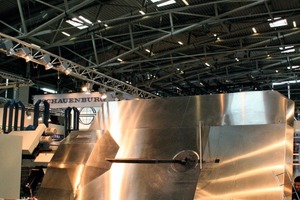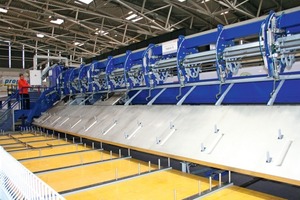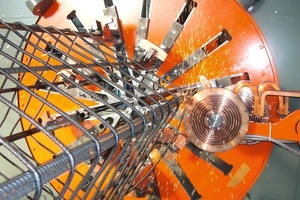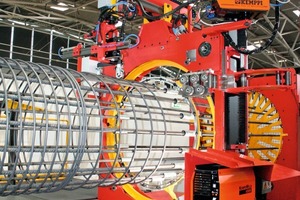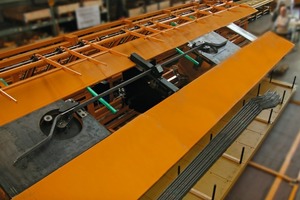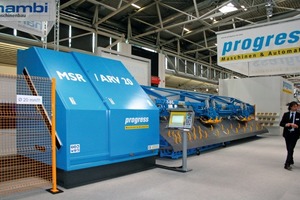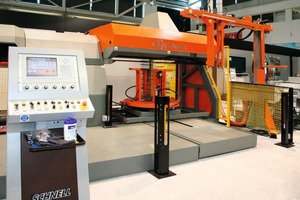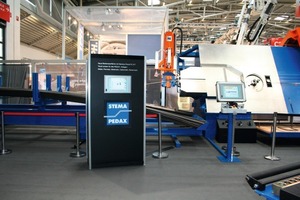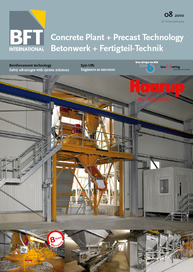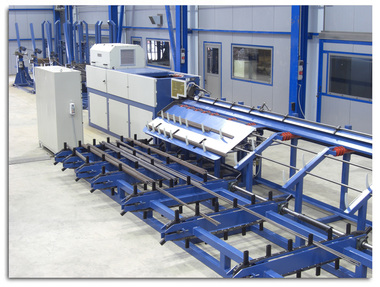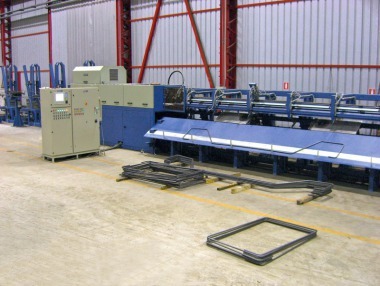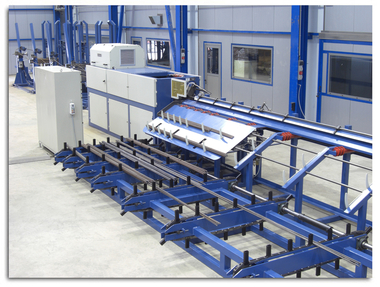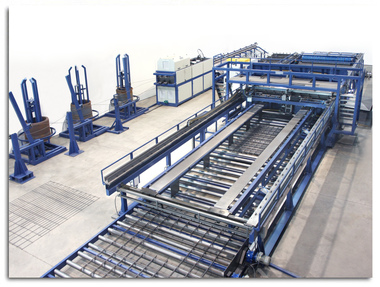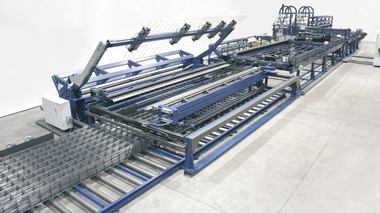New trends in reinforcement processing
bauma 2010 featured many improved and newly developed systems for the processing of reinforcing steel. The trend toward the processing of large rebar diameters has continued steadily during the past three years. Some markets report a demand for straightening, cutting and bending machines for rebar diameters greater than 20 mm. A number of innovations were also presented in the automation of stirrup bending. This report provides an overview of the exhibitors and their products on display at bauma 2010.
Eurobend S.A.
Eurobend SA presented their continuous spiral stirrup reinforcement machines of the Spiral SE and Spiral SP series at bauma 2010.
The Spiral SE series are the second generation of straightening, bending and cutting machines producing concrete reinforcing stirrups in continuous, multi-layer spiral form. Coiled rebar, high tensile pc-bar or wire from 5 to 16 mm can be processed with a minimum speed of
90 m/min, and any shape can be produced (i.e. square, rectangular, polygon, circular etc). Angles of ± 180° can be bent with a accuracy of ± 0,5° and a side accuracy of ± 0.5 mm.
The collection table is synchronized with the feeding and bending subassemblies and follows the movement of the produced spirals, enabling accurate spiral production, even for large shapes, dimensions and multiple layers.
Since the lower rollers of the straightening subassemblies are powered, they create a positive, precise and evenly distributed feeding force. Diameter changes can be completed in seconds, thanks to the “Hexagon Shaft Pre-setting System”. The adjustable counter-torsion (anti-twist) system always produces flat shapes regardless of rebar quality, axial twist and bending direction (patent). Through the ergonomic operator interface with user friendly software and the remote trouble-shooting via Internet, handling and operating is easy and convenient.
The Spiral SP series of spiral benders has been developed for the high-speed production of precision square and rectangular shaped spirals.
Four hydraulically operated bending heads mounted on a robust slide way achieve a high output with excellent accuracies and, more importantly, repeatability and consistent quality. Diameter changes can be completed in seconds, thanks to the “Pre-setting System”. Due to the mechanical simplicity, a minimum of maintenance is required. Yet the machine can be operated unsupervised due to the electronically controlled safety devices.
www.eurobend.com
EVG Entwicklungs- und Verwertungs-Gesellschaft m.b.H. / Filzmoser Maschinenbau GmbH
This year, EVG and Filzmoser ran a joint stand in Munich to display innovations in the field of mesh production and reinforcement of concrete. For the first time ever, EVG exhibited its Polycage Automatic Cage Welder. The Polycage is able to produce in a fully automatic manner reinforcing elements for columns and beams consisting of main bars with a maximum diameter of 32 mm and single stirrups with a maximum diameter of 16 mm. The rebar for the stirrups is pulled directly from coils, bent to the programmed shapes and then welded to the main bars by welding robots. After completion of one stirrup, the cage is advanced by means of a motorized pull-out system, and the next stirrup can be added.
The second innovation which was introduced by EVG at bauma 2010 as a world first is the fully automatic bar processing center DBE 28 designed to cut and bend rebar with diameters ranging from 8.0 to 28.0 mm.
This machine is the first implementation of a truly novel concept combining the Filzmoser double bending system DBE, which is today’s most advanced and field-proven rebar double bender, with a state-of-the-art bar pulling and cutting mechanism. Thus, maximum productivity can be achieved since pulling/cutting and bending are processes separated from each other and, therefore, can be performed simultaneously.A further advantage of this concept is the superior quality and accuracy of the bars and stirrups.
In order to ensure full automation, this machine includes a bar gripper for picking and separating the bars form the bundles and inserting them into the advance unit. Unlike other automated bar processing machines, the DBE also features a fully automatic changeover process including the automatic changeover of bending pins.
As a full range supplier to the reinforcing industry, EVG and Filzmoser display at their booth a range of standard benders and cutters for rebars, as well.
The manufacturing program of EVG includes welding lines with different degrees of automation for the production of reinforcing wire mesh, truss girders and gratings. Also, automatic bending machines for reinforcing steel, straightening and cutting machines for reinforcing wires and steel are manufactured. Last but not least, wire cold rolling lines and special welding lines for the production of „3D“ lightweight construction elements and tubbing reinforcement elements are completing the product portfolio.
Together with EVG, the mesh producer AVI and the steel and rolling mill Marienhütte form a group of companies offering the comprehensive program and know-how of a reliable and competent partner for conventional reinforcement of concrete.
Filzmoser, a subsidiary of EVG, has specialized in the development and construction of machinery for the processing of wire and reinforcing steel. Activities focus on rotor-type straighteners, rebar processing lines and automatic systems for the reinforcement of widespan precast concrete elements.
Among others, these are automatic processing and welding systems for truss girders or fully automatic welding and handling systems for reinforcement.
Together with EVG, Filzmoser offers a comprehensive program and know-how for conventional reinforcement of precast concrete elements.
www.evg.com; www.filzmoser.com
MBK Maschinenbau GmbH
The Southern German company presented their innovations and technical solutions on flat screens on a considerably prominent location.
MBK Maschinenbau GmbH Kisslegg manufactures reinforcement welding machines for the concrete pipe and construction industries. Dimensions for pipes range from 220 to 4,580 mm with wire diameters from 4 to 16 mm. A maximum length of 7,000 mm can be processed.
For civil engineering and building construction, MBK produces welding lines for round, rectangular, oval and square shaped cages in lengths of up to 24 meters and main bar diameters of up to 40 mm and wrap wire of up to 16 mm. Shielding gas and electrodes are not required because of the resistance welding principle, which provides an immediate return on investment.
www.mbk-kisslegg.de
MEP
The well known troubles in the European air traffic system impeded many to reach their destinations to the planned business schedule. However, MEP Group experienced an intense and significant attendance at the exhibition booth at the trade fair.
Visitors mainly focused on the many new solutions introduced, among them the latest HS generation. In line with four decades of tradition, MEP remain committed to developing technological solutions capable of meeting the widest range of industry requirements efficiently whilst helping to reduce production costs.
At bauma 2010, MEP presented, among other products, the automatic Format 16 HS 3D bender, which processes rebar diameters of up to 16 mm to stirrups. The system processes steel off the coil. This machine offers all the features of the previous automatic HS benders manufactured by MEP. It addition, it provides the advantage of fabricating three-dimensional shapes. The patented 3D design permits the fully automatic production of a wide variety of three-dimensional layouts in variable dimensions. To date, common rebar diameter ranges in 2D processing have been 6 to 16 mm (single wire) and up to 12 mm (double wire). The new 3D machines can process single wires from 6 to 16 mm.
Another highlight on display at the stand was the new GAM HS, which is a welding machine for reinforcement cages mainly designed to produce cylindrical and polygonal shapes. The welding robot is part of the latest generation of machinery and provides a high degree of efficiency and flexibility.
www.mepgroup.com
Oscam S.p.A.
At bauma 2010, Oscam presented a novelty: the first automatic loader for double benders used for reinforcement steel.
Whereas some automatic loaders had already been available for cutting machines, as well as several machines that automatically cut and bend a limited number of bars, nobody up to now produced a system able to count and feed reinforcement bars to automatic bending machines like the big robotic double benders. This is a problem that is more difficult to solve than feeding cutters since the bars must be introduced into both bending units in a defined sequence, rather than at random.
This is particularly important in big factories where a single big shearline has to feed several bending units. Having an automatic feeder for robotic double benders not only eliminates counting errors, increases output and enhances efficiency, but it is also an important improvement in the safety of the factory as bending operations may pose the greatest hazards to the workforce.
With the new system, bending operations can be performed fully automatically, reducing workplace risk to zero. Their new automatic counting and feeding unit makes it possible to load the bars quickly and in a fully automatic way from the random (and variable in size, diameter and number of bars) bundles that come from the cutting stage. Unlike in conventional feeders for cutters, there is no need to adapt or prepare the bars in a certain order.
The new system enables loading of the bars either from the traditional feed device of the shearlines (the roller tracks or chain conveyor pockets for instance) or from a dedicated buffer stock at your choice.
Rebar can also be fed from the coil and from straight bars if the user wants to use it for both materials.
The double bender at the exhibition had also an automatic unloading of the bent bars, thus allowing to operate the machine without any operator in all phases. However, the loader can also be installed on conventional double benders since its design prevents any risk for people standing near the machine.
In 1987, Oscam introduced the first automatic feeding unit for cutting machines. At bauma 2010 the company launched the latest version of counting and feeding units for shearlines. Its much simpler design permits trouble-free operation, does not require sophisticated controls and makes it possible to work a larger range of bar diameters, eliminating many limitations of the previous systems.
Most importantly, it allows to load the bars much faster than all previous systems.
Furthermore, it is possible to put a buffer between the shearline’s infeed track and the feeding unit, for instance a chain conveyor, to store the lots ready to be loaded, which further enhances the speed of the shearline’s operation. By contrast, the feed systems available before were often automated but ran at a slower speed compared to the conventional manual feed. The system can also be viewed in operation in a real-life factory environment.
Oscam also introduced the latest version of the mesh double bender that allows operating two bends at the same time on a mesh sheet and has an automatically controlled translation of the bending units. This machine is particularly suitable for the processing of large quantities of mesh.
Multibend 12, the smallest of its range of automatic stirrup machines from coil, was exhibited as well.
Economical but fast, it is precise and built with first-class materials. For instance, the plate is exclusively made of stainless steel. Oscam also presented the latest developments in the range of hoop-spiral machines.
www.oscam.com
progress Maschinen & Automation AG
At bauma 2010, the stand of the company from Brixen was divided into three areas. The presentation focused on straightening, cutting and bending, as well as on mesh welding. Pipe reinforcement was shown as the third area on one side of the stand.
“Our stand has a clear structure and addresses various target audiences very specifically, which is key to a successful trade show presence”, says Sales Manager Albert Blasbichler.
Among other products, Progress displayed the MSR/ARV 20 for the straightening, cutting and bending of reinforcing steel from coiled stock. This machine can process rebar in diameters of up to 20 mm. The machine on display was equipped with automatic rotor adjustment, a flying shears system and an automatic die change. A particular feature of this machine is its bending section, which enables the simultaneous bending of two wires in diameters of up to 16 mm.
In the field of mesh welding, the M-System Evolution system was presented. This type of machine is particularly suitable for the welding of custom mesh or mesh with varying grids, dimensions and wire diameters.
For pipe reinforcement, Progress exhibited the VTA 200 cage welder. Progress presented this machine for the first time at this year’s bauma following the take-over of the long-established company Vida in 2008. Since then, the product range has been expanded by the VTA (welding machines for reinforcement cages) and VGA (lattice girder production machines) series.
The VTA series produces cylindrical reinforcement cages with and without socket. The integrated inverse welding system requires only low connected loads. Controlled welding ensures top quality with a very low degree of sparking.
Unfortunately, the number of stand visitors did not reach a new record, as originally expected. Due to the volcanic ash cloud blocking air traffic, visitors from overseas in particular had to cancel their trip to the bauma. Despite this fact, the company was satisfied with the outcome: “We were able to establish valuable new contacts but also to intensify existing customer relationships. For us, bauma has been a success,” says Albert Blasbichler.
www.progress-m.com
Schnell S.p.a
During bauma 2010, the Italian manufacturer presented Spirex, the innovative machine for the production of a new reinforcement of concrete beams and columns.
Spirex is a continuous stirrup with a particular design whose vertical arms are always perpendicular to the main reinforcement while the horizontal arms diverge, determining the pitch (also variable) between the different stirrups.
The continuous stirrup Spirex eliminates all the errors that may occur on the jobsite during the placing of the reinforcement. Spirex is a single piece of steel rod, very fast and simple to use, which matches the original project of engineers, without any possibility of negligence and damage.
Being the Spirex continuous stirrups produced with a pre-established pitch, stirrups (spirals) are always in the right position along the reinforcement, even with variable pitches. The risk that the number and the position of the stirrups along the reinforcement couold be changed erroneously is eliminated.
It is not important that every stirrup (spiral) be tied to the longitudinal bars of the reinforcement because, as the stirrups are connected to each other, they do not move from their position during the pouring of the concrete.
Being Spirex a continuous spiral, without any interruption between the stirrups, stirrups cannot open when under load (earthquake).
It also allows considerable time and assembly cost savings with a reduction of up to 70% in the installation time of the reinforcement.
Spirex also solves the problem of positioning the stirrups into the joints between pillars and beams: a small compressed Spirex is inserted around the joints to be reinforced, and once the upper and lower longitudinal reinforcements are placed, the spiral unfastens and returns automatically as developed in the project.
During the Bauma, Schnell also presented the new stirrup bender COIL 16 EVO for rebar processing up to 16mm with its new pulling and straightening system able to reach more than 200m/min.
www.schnell.it
Stema/Pedax
Stema/Pedax, a cooperation between the Danish Stema Engineering A/S and the German Pedax Bitburg Maschinenbau GmbH, presented their new products and further developed versions for concrete reinforcement. All of their machines comprise servo drives to increase the accuracy in production and reduce the maintenance compared to hydraulic drives. A further advantage of servo drives is the continuously adjustable processing speed.
Metamatic, the new automatic system for cutting and bending reinforcing steel from bars, is now available in three different models for bar diameters of up to 22 mm, up to 28 mm and up to 32 mm. Metamatic processing centres are individually tailored to the needs of the user by incorporating the desired components of a modular system.
An automatic counting and feeding unit, as well as a rapid tool changer with pneumatic locking, can be supplied as an option.
On display was also the new Rectormatic automatic straightening system for reinforcing steel from coils, which has been developed for use in Schlatter mesh welding plants. It is equipped with a total of eight hyperbolic straightening rotors that deliver outstanding straightening results. Each of the new rotors has six straightening rollers. The drive motors are sized to be sufficiently powerful to straighten even very high strength (> 850 N/mm²) coil safely and cleanly.
The new wire magazine of the Twinmaster 20 III has two positions: for 1 x diameter 20 mm and for 2 x diameter 12 to 16 mm. Apart from this, the new Twinmaster 20 is designed just like its “smaller brother”, the Twinmaster 16 III. New heavy-duty reels that are suitable for this machine have been developed specifically for coil material weighing up to 5 tonnes. To prevent twisting of the wire, a new wave-straightening process guarantees outstanding straightening performance.
Since bauma 2010, the automatic stirrup machine Twinmaster 16 X+ has also been available with automatic wire change. Up to nine coils with electric reverse pulling mechanism can be controlled and programmed to work with the wire magazine via the front panel. This new wire magazine is a perfect match to online ordering systems such as BVBS.
www.stemapedax.com
Note from the editor: the list of exhibitors of this sector mentioned in this article is not exhaustive.

